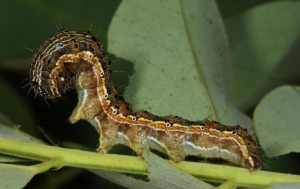Brazil Declares Emergency in Seventh State

Helicoverpa larvae are aggressive, occasionally carnivorous and may even cannibalize each other.
Photo credit: Gyorgy Csoka, Hungary Forest Research Institute, Bugwood.org
Creative Commons license
Brazil’s Ministry of Agriculture, Livestock and Supply (MAPA) on Thursday declared a state of emergency in Alagoas, citing the Helicoverpa armigera outbreak that has cost the country’s farmers billions of dollars.
The state of emergency — in effect for one year — has also been declared in Bahia, Goiás, Mato Grosso, Mato Grosso do Sul, Minas Gerais and Piauí. The caterpillar has attacked corn, soy and cotton, as well as string beans, okra, peanuts and chili.
Among the emergency measures to be adopted, according to MAPA: the use of cultivars that restrict or eliminate pest populations; determining planting and restriction of subsequent crops; determining the adoption of integrated pest management of emergency, use of biological control, use chemical control, using traps, baits or other methods of physical control; release of biological control agents as well as cultural practices, such as the destruction of crop debris and volunteer plants.
“The emergency declaration is important because it will allow the input of resource to combat the plague,” said the general coordinator of Plant Protection Map, Carlos Arthur Franz.
According to CropLife Latin America, Helicoverpa armigera is originally from Africa and currently threatens crops across Asia, Europe and Oceania. It was identified in South America in February of 2013 by researchers from the Brazilian Agriculture and Livestock Research Company (Embrapa); Silvana Paula-Moraes and Alexandre Specht from Embrapa Cerrados and by Daniel Ricardo Sosa-Gomez from Embrapa Soybean, through morphological and DNA analyses in male adults. Characterizing the outbreak are a high level of resistance to insecticides, high mobility and an elevated reproduction rate with females laying 1,000 to 1,500 eggs.






